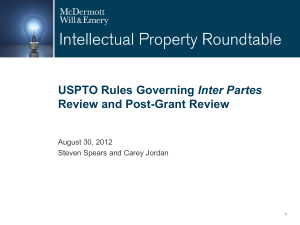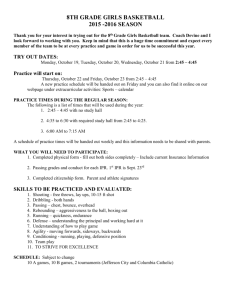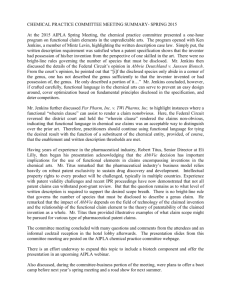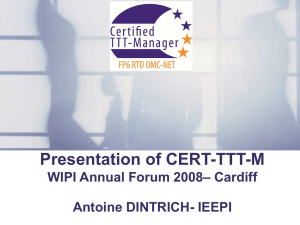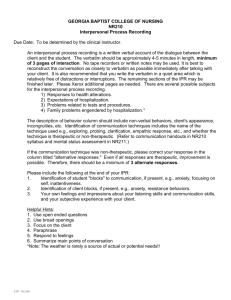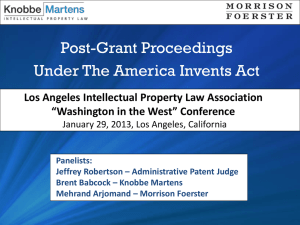Update on AIA Trial Proceedings - AIPLA IPP Europe Trip 2015_Peter
advertisement
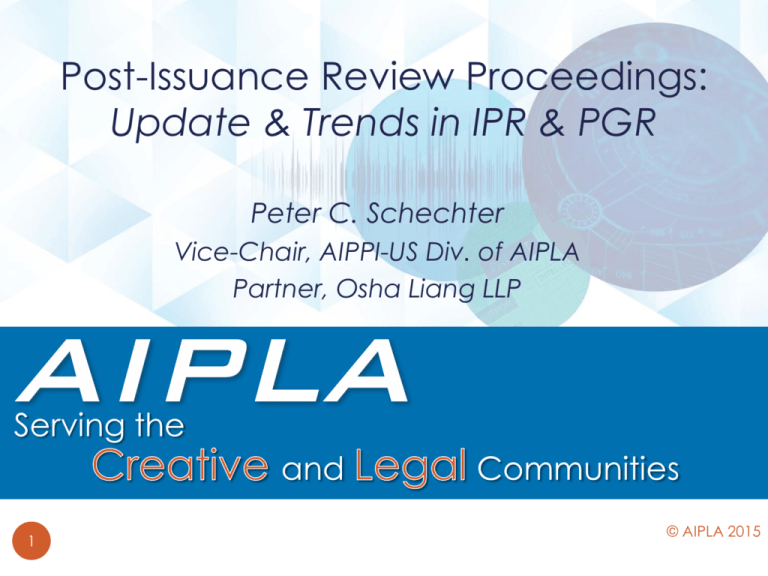
Post-Issuance Review Proceedings: Update & Trends in IPR & PGR Peter C. Schechter Vice-Chair, AIPPI-US Div. of AIPLA Partner, Osha Liang LLP Serving the and 1 Communities © AIPLA 2015 Disclaimer The purpose of this presentation is to provide educational and informational content and is not intended to provide legal services or advice. The opinions, views and other statements expressed by the presenter are solely those of the presenter and do not necessarily represent those of AIPLA or of AIPPI-US. 2 © AIPLA 2015 Post-Issuance Trial Proceedings AIA created several new procedures for third party initiated review of patents after issuance, including: Post-Grant Review (“PGR”) 35 U.S.C. § 321 et seq. - Challenges on any basis Inter Partes Review (“IPR”) 35 U.S.C. § 311 et seq. - Challenges based on patents and printed publications 3 PGR – Availability & Timing • Available for post-AIA patents ONLY (i.e., filed on or after 16 March 2013) • File within 9 months of issuance of original patent or broadened reissue patent • Only SIX filed (as of 14 May 2015) • No final written decisions yet • Important timing issues/strategies with respect to blocking IPRs 4 © AIPLA 2015 IPR – Availability & Timing • For post-AIA patents • File after later of expiration 9- month PGR window, or termination of PGR • Important strategic consideration for Patent Owner • For pre-AIA patents • Can be filed at any time • 2,894 filed as of 14 May 2015 5 © AIPLA 2015 Patent Trial and Appeal Board Trial-like processes Patent Trial and Appeal Board (“PTAB”): Adjudicative, not examination, process conducted by panel of 3 Administrative Patent Judges (“APJ”) Oral Hearing: Either party may request an oral hearing before the PTAB No claim amendments during hearing Appeal: Directly to the CAFC – no district court action allowed 6 © AIPLA 2015 IPR Filings to date • Breakdown of AIA petitions (through 14 May 2015): • 63% in Electrical and Computer arts • 24% in Mechanical arts and Business Methods • 8% in Bio/Pharma arts • 5% in Chemical arts 7 © AIPLA 2015 Current IPR Hot Topics Standard for Claim Interpretation PTAB uses the “broadest reasonable interpretation consistent with the specification” approach to claim interpretation justified by o Use of this standard during initial examination o Patent Owner’s ability to amend claims In practice, the Patent Owner has little or no ability to amend claims Claim interpretation asserted by the Patent Owner in district court litigation is NOT used This approach has been criticized and may be changed by legislation 8 © AIPLA 2015 Current IPR Hot Topics Whether to file the OPTIONAL Patent Owner’s Preliminary Response Due 3 months from order granting filing date Explanation of why IPR should not be instituted Submission of documentary evidence allowed, but testimonial evidence, i.e., declarations, permitted only where “interests of justice” require; few, if any, permitted, to date POPR filed in: FY2013 – 79% of IPR (94% of CBMR) FY2014 – 80% of IPR (87% of CBMR) FY2015 (a/o 14 May 2015) – 85% of IPR (92% of CBMR) 9 © AIPLA 2015 Current IPR Hot Topics Low Threshold for Institution IPR Trial instituted upon demonstration of “reasonable likelihood” that Petitioner would prevail with respect to at least one challenged claim Unpatentability must be shown by a preponderance of the evidence NOT an especially difficult standard to meet Note: institution decision is not “all or nothing” Made on a claim-by-claim and a ground-by-ground basis Due 6 months from petition filing date 10 © AIPLA 2015 Current IPR Hot Topics Page Limits: Can be problematic for patents with many claims / multiple grounds 60 pages: Petition (single-spaced claim charts are allowed, but claim charts may not include argument) PO Preliminary Response PO Response 25 pages (increased from 15 on 19 May 2015): Petitioner’s Reply to PO Response PO Motion to Amend (claims presented in separate appendix, not in counted pages) 11 © AIPLA 2015 Current IPR Hot Topics Page Limits: 15 pages: All other motions, oppositions to motions 5 pages Replies to oppositions, except 12 pages for Reply to PO Motion to Amend (as of 19 May 2015) ALL PTAB filings must (as of 19 May 2015) use “14-point Times New Roman proportional font with normal spacing” 12 © AIPLA 2015 Cost $23,000 ($9K for “request” + refundable $14K for “review”) plus … $200 “request fee” for each additional challenged claim > 20, plus … Refundable $400 “review fee” for each additional challenged claim > 15 13 © AIPLA 2015 Current IPR Hot Topics Follow-on Petitions In most cases, IPR trial is instituted on some, but not all, challenged claims Motions for reconsideration have been unsuccessful Parties frequently file a second, slightly different petition to attack the non-instituted claims No clear/consistent standard for how these are treated Discretionary with PTAB o In one recent decision, PTAB held that institution in follow- on petition is not required even where conditions are otherwise met (i.e., not based on the same or substantially the same prior art or arguments) 14 © AIPLA 2015 Current IPR Hot Topics Petitioner’s risk in relying on non-patent prior art Unforeseen area of conflict and expense Little uniformity in PTAB’s acceptance of the prior art status of non-patent prior art Even based on actual dates of publication thereon Even as to standard industry journal articles Evidentiary and substantive objections have become a common tactic Followed by hotly contested motions to exclude prior art Publications dates must generally be corroborated with sworn declaration evidence o Declarant must be made available in the US for a live deposition o Very difficult burden on petitioner Consumes disproportionate share of time and expense of IPR proceeding 15 © AIPLA 2015 Strategic Considerations: Timing & Stay of DJ Litigation File DJ Action for Invalidity File Petition for Inter Partes Review Petition Denied File Petition for Inter Partes Review File DJ Action (but not counterclaim) for Invalidity Litigation automatically stayed Petitioner Served with Complaint for Infringement Inter Partes Petition Filed More Than 1 Year Later Petition Denied Clear trends -- most courts will deny or hold in abeyance motions 16 to stay before institution decision rendered by PTAB, will stay infringement actions if IPR trial is instituted early in the litigation © AIPLA 2015 Strategic Considerations: Estoppel Issues Petitioner estoppel: immediately upon issuance of final written decision, unsuccessful challenger is estopped as to any ground of invalidity raised or that reasonably could have been raised – but ONLY AS TO CLAIMS INSTITUTED AND ADJUDICATED No statutory estoppel as to claims for which IPR trial was NOT instituted 17 © AIPLA 2015 Strategic Considerations: Estoppel Issues PO estoppel: if a claim is cancelled, refused or otherwise deemed unpatentable by adverse judgment, then no subsequent action is allowed (e.g., reissue, adding claim to pending application) that would result in obtaining a claim “patentably indistinct” from any claim finally refused or cancelled 18 © AIPLA 2015 IPR: An Instant Hit TOP TEN REASONS 19 1. EASY INITIATION 6. EASY BOARD ACCESS 2. PREPONDERANCE TEST 7. SETTLEMENT POSSIBLE 3. BRI CLAIM INTERPRETATION 8. RELATIVELY SPEEDY 4. AMENDMENT DIFFICULT 9. LITIGATION STAY LIKELY 5. LITTLE DISCOVERY 10. COST Thank You! Peter C. Schechter Osha Liang LLP Two Houston Center 909 Fannin St., Suite 3500 Houston, Texas 77010 Direct: 914.260.2314 Office: 713.228.8600 schechter@oshaliang.com 20
